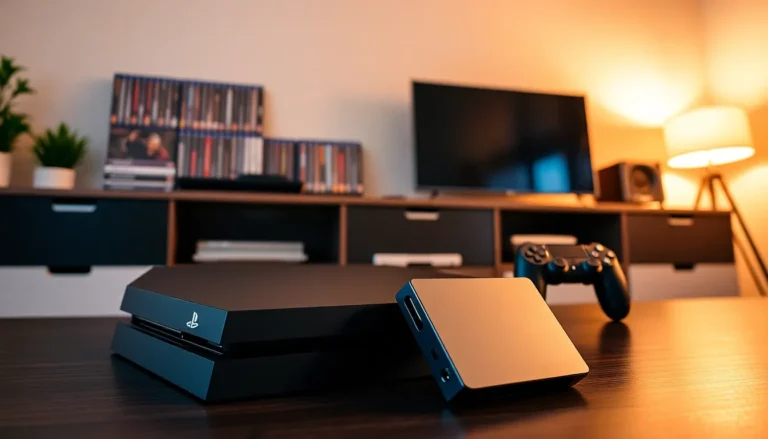Table of Contents
ToggleOverwatch has taken the gaming world by storm, and if you’re diving into competitive play, understanding your Overwatch rating is crucial. Think of it like that awkward first date, alarming yet essential, revealing the true state of your abilities and potential. While some players are cruising smoothly in Grandmaster tier, others might be floundering in Bronze. No shame in that: just a lot of room for improvement. So, buckle up as we unravel the mysteries behind the competitive rankings and how to climb to the top with confidence.
What Is Overwatch Rating?

In Overwatch, the rating system serves as a numerical reflection of a player’s skill level. Simply put, this system classifies players into various tiers based on performance in competitive matches. With ranks ranging from Bronze to Grandmaster, players are assigned a rating that helps to create balanced matches. Each player’s competitive journey begins here, making it a pivotal element in the game.
Not to be overlooked, this rating isn’t just a fancy number. It impacts matchups, and the experience of players involved in competitive gameplay. Whether a newbie or a veteran, one thing is for sure: understanding the rating system aids significantly in navigating the competitive landscape of Overwatch.
By knowing where one stands, players can set achievable goals and assess their progress over time.
The Importance of Ratings in Competitive Play
Ratings carry a weightier significance than merely determining if a player gets a shiny badge. They influence matchmaking, which means higher ratings lead to tougher opponents. But, lower ratings might match a player with those still learning the ropes.
This process ensures that games remain engaging, balanced, and entertaining. Besides, players can validate their growth while experiencing the joy of consistent improvement. Imagine the thrill of finally surpassing that dreaded rank you seemed glued to for ages. Ratings also foster a sense of community, as players often share their experiences, tips, and strategies based on their rank. Discussions about different ranks can often bring players together, creating a more vibrant gaming environment. In essence, ratings help define the competitive journey, encouraging players to push their limits and reach new heights.
How Overwatch Rating Is Calculated
Understanding how Overwatch rating is calculated unveils yet another layer of the competitive experience. The system hinges on various factors, ensuring that one’s performance is appropriately accounted for. Players earn or lose rating points based on the outcomes of matches, with a few nuances involved.
Different Types of Ratings in Overwatch
In Overwatch, there are multiple types of ratings that contribute to a player’s standing. Besides the skill rating (SR), competitive points (CP) add depth to the overall rating system. Each serves its distinct purpose, creating a well-rounded competitive profile.
Skill Rating (SR) Explained
Skill rating, often termed SR, is the most recognizable aspect of a player’s rating. It ranges from 1 to 5000, divided into tiers. Winning matches increases SR, while losses decrease it. The placement matches at the season’s start significantly influence initial SR.
Competitive Points (CP) and Their Role
Beyond SR, competitive points reward players for their efforts throughout a season. Although CP doesn’t directly impact SR, they are essential for unlocking exclusive rewards, like skins and competitive modes. Players accumulate CP based on their final SR at the end of a season, so providing motivation to keep climbing those ranks.
Seasonal Changes and Their Impact on Ratings
Overwatch ratings aren’t static. With each new season, players encounter shifts and changes that impact their competitive journey. Season resets often bring adjustments in the rating system itself and introduce new maps, heroes, or adjustments in gameplay.
Besides, the competitive landscape can feel different as the evaluated skill expectations may change from one season to another. This change encourages players to adapt continually and stay on their toes. It’s common for players to see fluctuations in their ratings during these resets, highlighting the necessity for resilience and adjustment. Understanding how these seasonal changes work allows players to strategize their approach, ensuring they can adapt and thrive, no matter the obstacles presented.
Tips to Improve Your Overwatch Rating
Improving one’s Overwatch rating involves several strategies, and players can take actionable steps to ascend in ranks effectively.
Common Mistakes Players Make
Many players fall into familiar traps: for instance, blaming teammates for losses instead of assessing personal performance. Self-reflection is key. By identifying weaknesses, such as communication or character selection, players can begin to sharpen their gameplay.
Utilizing Tools to Track Your Progress
Several tools are available for players looking to track their performance diligently. Apps and websites offer real-time stats, allowing players to analyze their gameplay and record progress. These tools can help identify strengths, highlight areas needing work, and set tangible goals for improvement. By leveraging technology, players can turn data into actionable plans, paving the way to enhance their Overwatch rating.





